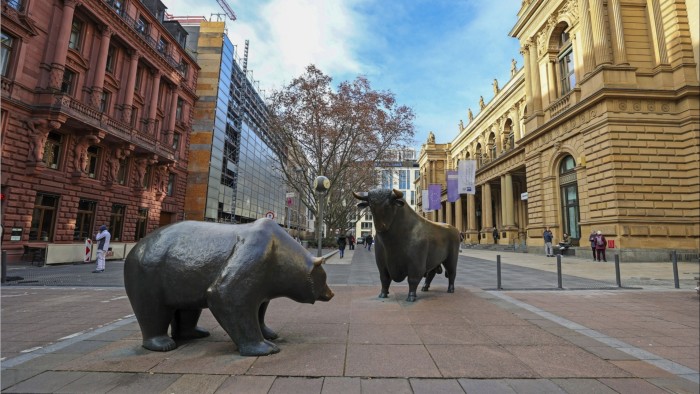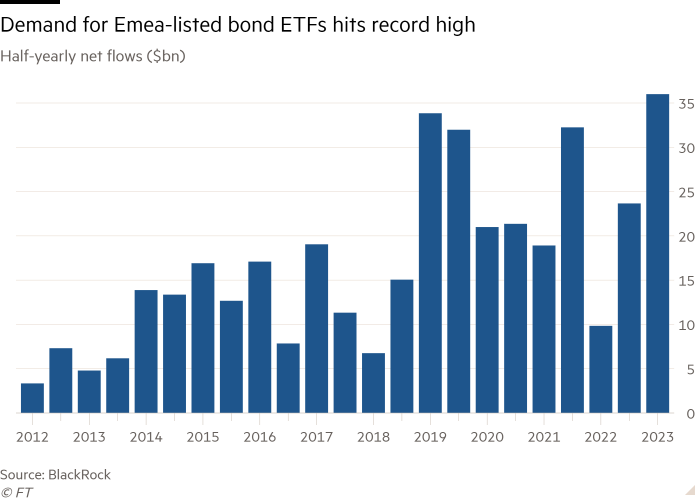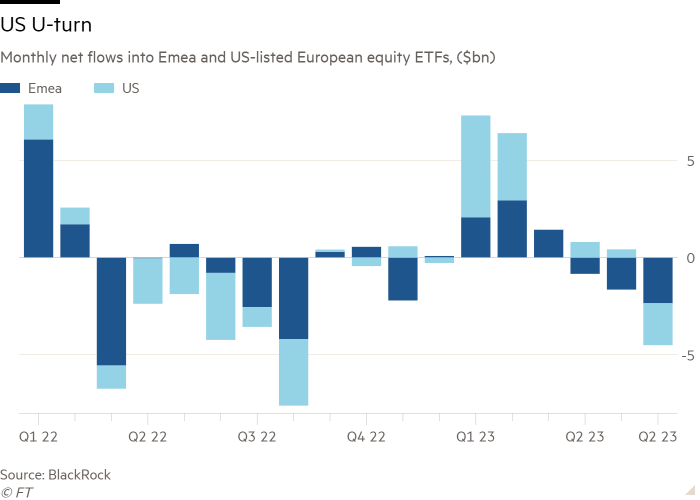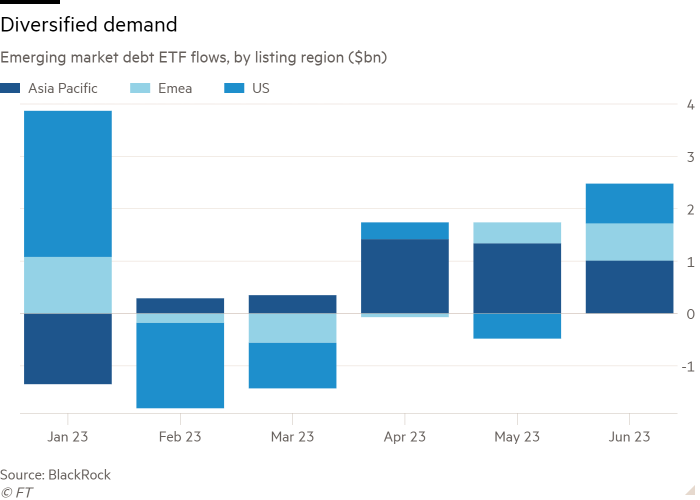Demand for European bond ETFs hits record high in first half

Simply sign up to the Exchange traded funds myFT Digest -- delivered directly to your inbox.
Latest news on ETFs
Visit our ETF Hub to find out more and to explore our in-depth data and comparison tools
Demand for European fixed income exchange traded funds hit record levels in the first six months of 2023, as investors rushed to take advantage of higher bond yields.
Investors poured a net $36bn into bond funds listed in the Europe, Middle East and Africa region in the first half of the year, according to data from BlackRock, surpassing the previous record of $33.8bn set in the first half of 2019.
On a global basis, fixed income ETFs have pulled in a net $165.4bn so far this year, a record start to the year, although just shy of the tally recorded in the second half of 2022.
The bond bonanza comes as inflows and rising markets have pushed the total assets of the ETF industry to $10.3tn, surpassing the prior peak of $10.2tn set in December 2021, just as markets were starting to head south.
Karim Chedid, head of investment strategy for BlackRock’s iShares arm in the Emea region, said rising bond yields were luring investors into the fixed income market.
The yield on the 10-year Treasury, for instance, has risen from less than 1.5 per cent at the start of last year to nearly 4 per cent, as the Federal Reserve has raised interest rates aggressively.
“[Investors] want to lock in yields at these levels before they drop,” said Chedid.
“European investors had even lower yields for a long time, so it’s an even bigger trend [than in the US],” he said, adding that he believed it had longer to run.

He also thought that some investors were looking for a “diversifier from equities”, with the eurozone already in a technical recession and fears that this could spread.
Julien Scatena, head of marketplace at Trackinsight, said that while in the Americas the bulk of ETF money was flowing into equity funds, “in Europe, fixed income strategies continue to be attractive from the perspective of a [potential] pivot point in the monetary policy conducted by central banks”.
Looking more broadly, Deborah Fuhr, managing partner of ETFGI, a consultancy, pointed to enthusiasm for European-domiciled ETFs overall, after they pulled in a “fairly phenomenal” net $87.3bn in the first six months of 2023, compared to $89bn in the whole of last year.
“In general people are preferring the ETF wrapper,” with retail investors becoming increasingly active in a European market that has long been dominated by institutional money, Fuhr said.
“[Investors] have become slightly more positive and the markets are rallying, which has caused people to put more money to work,” she added.
Overall, net flows into global ETFs hit $98.3bn in June, according to BlackRock, up from $78bn in May and the highest monthly figure this year.
Equity funds accounted for $75.8bn of this, with US-listed funds soaking up $45.2bn, their strongest inflows since October.
“In the second quarter of 2023, ETF investors in the US rotated heavily back into funds that provide exposure to domestic US equities,” said Aniket Ullal, head of ETF data and analytics at CFRA Research.
Looking purely at US-listed funds, Ullal said US equity ETFs took in $64bn in net flows in Q2, “a sharp reversal from a dismal Q1 where these ETFs had outflows of $2.5bn”.
Ullal also noted the popularity of actively managed ETFs, which helped JPMorgan take second place behind Vanguard in the US H1 ETF flows leaderboard, despite it only ranking seventh in assets. Dimensional Fund Advisors and Avantis Investors also punched above their weight.
“Throughout 2023, assets flowing into actively managed strategies surged by over 20 per cent in the Americas, underscoring the growing popularity and confidence in the active management approach,” said Scatena.
Enthusiasm for equities was not universal, however, as for the first time this year US investors “meaningfully sold” European equity ETFs, potentially signalling the end of a period where “international investor flows into European equities have been stickier versus history,” Chedid said.

He attributed this repatriation to performance differentials, with European bourses’ erstwhile outperformance of Wall Street having “faltered since the third week of May”.
“The European growth picture that was better than expected for the last six months is starting to lose steam,” added Chedid. He noted that year-to-date 25 per cent of all US equity ETF inflows have gone into ETFs targeting “quality” stocks, compared to just 1 per cent in Europe, a figure that “has scope to increase from here”.
Gold also appears to be losing its shine, with the net outflows of $3.8bn from gold funds, the largest monthly exodus since September 2022, unwinding much of the $4.2bn that was added during March and April.
Gold is often seen as an inflation hedge, so as “disinflation has gathered steam”, demand has fallen, Chedid said.

More positively, and very unusually, emerging market debt benefited from net buying by investors in all three major regions: the US, Emea and Asia Pacific.
Chedid said optimism around EM local currency debt was a “high conviction view” for BlackRock and that this trade “has further to run”.
Even after the latest flows, foreign ownership of EM bonds (ex-China) is just 20-30 per cent, he said, compared to close to 50 per cent in 2017, “suggesting there is room for further buying”.

Comments